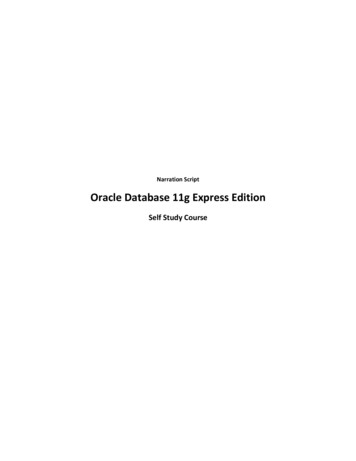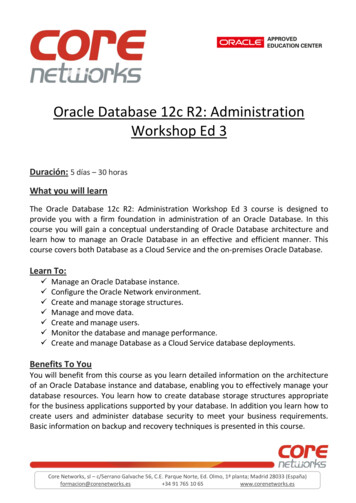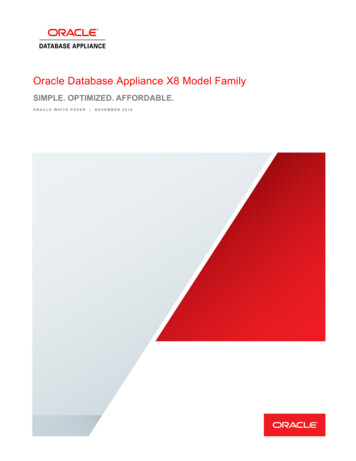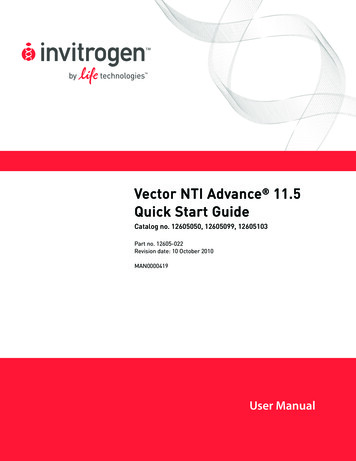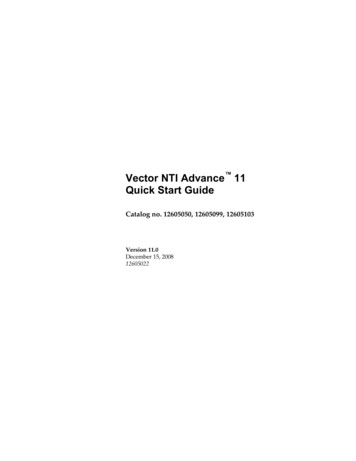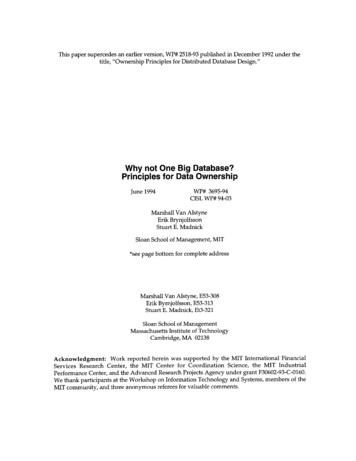
Transcription
This paper supercedes an earlier version, WP# 2518-93 published in December 1992 under thetitle, "Ownership Principles for Distributed Database Design."Why not One Big Database?Principles for Data OwnershipJune 1994WP# 3695-94CISL WP# 94-03Marshall Van AlstyneErik BrynjolfssonStuart E. MadnickSloan School of Management, MIT*see page bottom for complete addressMarshall Van Alstyne, E53-308Erik Byrnjolfsson, E53-313Stuart E. Madnick, Et3-321Sloan School of ManagementMassachusetts Institute of TechnologyCambridge, MA 02138Acknowledgment: Work reported herein was supported by the MIT International FinancialServices Research Center, the MIT Center for Coordination Science, the MIT IndustrialPerformance Center, and the Advanced Research Projects Agency under grant F30602-93-C-0160.We thank participants at the Workshop on Information Technology and Systems, members of theMIT community, and three anonymous referees for valuable comments.
Why Not One Big Database?Principles for Data OwnershipAuthors:Affiliation:Correspondence Address:Marshall Van AlstyneErik BrynjolfssonStuart MadnickMIT Sloan SchoolMarshall Van AlstyneMIT Sloan SchoolRm. E53-30830 Wadsworth StreetCambridge, MA 02139marshall@athena.mit.eduAcknowledgment: Work reported herein was supported by the MIT InternationalFinancial Services Research Center, the MIT Center for Coordination Science, the MITIndustrial Performance Center, and the Advanced Research Projects Agency undergrant F30602-93-C-0160. We thank participants at the Workshop on InformationTechnology and Systems, members of the MIT community, and three anonymousreferees for valuable comments.
Van Alstyne, Brynjolfsson, Madnick2Why Not One Big Database?Principles for Data OwnershipAbstract: Results of this research concern incentive principles which drive informationsharing and affect database value. Many real world centralization and standardizationefforts have failed, typically because departments lacked incentives or needed greaterlocal autonomy. While intangible factors such as "ownership" have been described asthe key to providing incentives, these soft issues have largely eluded formalcharacterization. Using an incomplete contracts approach from economics, we model thecosts and benefits of restructuring organizational control, including critical intangiblefactors, by explicitly considering the role of data "ownership." There are two principalcontributions from the approach taken here. First, it defines mathematically preciseterms for analyzing the incentive costs and benefits of changing control. Second, thistheoretical framework leads to the development of a concrete model and sevennormative principles for improved database management. These principles may beinstrumental to designers in a variety of applications such as the decision todecentralize or to outsource information technology and they can be useful indetermining the value of standards and translators. Applications of the proposedtheory are also illustrated through case histories.Keywords: Database Design, Centralization, Decentralization, Distributed Databases,Ownership, Incomplete Contracts, Incentives, Economic Modeling, Standards,Outsourcing, Translation Value
Van Alstyne, Brynjolfsson, Madnick31.1 Introduction: "Why not one big database?"Information systems designers often argue that centralized control is bettercontrol. From a technology standpoint, this is readily defensible in terms of dataintegrity and enforcing a uniform standard.From an economic standpoint,centralization limits the costs of redundant systems. In addition, stories of confusionsometimes characterize decentralization. One senior executive at Johnson and Johnsonwaited three weeks for the list of his corporation's top 100 customers world-wide due toproblems linking multiple systems. Difficulties with "dis-integrated" systems have ledsenior staff to inquire "Why not create one big database or at least control them all fromone central location?" With optical technology and newer microprocessors, barriersimposed by communications bandwidth and speed-bound central hardware continue tofall. Local data control no longer seems necessary or warranted.Technical considerations, however, represent only part of a more complex storyin which less tangible managerial and incentive issues play a critical role. We present aframework demonstrating that local control can be optimal even when there are notechnicalbarriers to complete centralization. This assertion is based on research showingthat "ownership" is a critical factor in the success of information systems.In developing an "interaction theory" of people and systems, Markus [19]observes that problems with a database at a large chemical company arose fromchanges in control. After implementing a new information system, "all financialtransactions were collected into a single database under the control of corporateaccountants. The divisional accountants still had to enter data, but they no longer owned
Van Alstyne, Brynjolfsson, Madnick 4it."1 Similar arguments are put forth by Maxwell [21] and Wang [30]. Of the factorsMaxwell considers most important to improving data quality, data ownership andorigination are among the most critical. Spirig argues that when data ownership andorigination are separated, information systems cannot sustain high levels of dataquality. 2 Ralph Larsen, the CEO of Johnson and Johnson, states unambiguously, "Webelieve deeply in decentralization because it gives a sense of ownership."3The key reason for the importance of ownership is self-interest: owners have agreater vested interest in system success than non-owners. Just as rental cars are drivenless carefully than cars driven by their owners, "feudal" databases 4 -- those not ownedby their users -- are maintained less conscientiously than databases used by theirowners.Ignoring ownership is also one possible explanation for IS failures since theimpetus for system development is external to the groups being affected. In fact,evidence suggests that most top-down strategic data planning efforts never meetexpectations [11]. Orlikowski [23] has observed that employees in a major consultingfirm refused to share information despite senior management encouragement,company-wide introduction, and an industry standard group support tool. Culture andincentives opposed the knowledge transfers which the technology was designed tosupport. In the words of one IS practitioner, "No technology has yet been invented toconvince unwilling managers to share information.have simply become too valuable to give away.1p. 438. Emphasis is the original author's.Cited in [30 p. 31] .3[7] Emphasis added.4Terminology adapted from Davenport.2. ."[9 p. 56]Information assets
Van Alstyne, Brynjolfsson, Madnick 5The issues highlighted in these studies [9, 11, 19, 23] are organizational nottechnical. Prior to deciding on the implementation of features and functionality, itbecomes necessary to ask who should have the power to decide? Will an outsourcingcontractor decide on system features which are in the strategic interests of the firm?Will one department sufficiently value the interests of another regarding databaseintegrity?These questions link technology issues to management concerns at afundamental level. In response, we develop the concept of data ownership to provide amechanism for ensuring that key parties receive compensation for their efforts.This is developed into two separate contributions. First, a rigorous model givesmathematical definitions of non-technical costs and benefits arising from changes indatabase control. Using the "incomplete contracts" approach pioneered by Grossmanand Hart [12] and applied to information assets by Brynjolfsson [5], it formalizesintuitive concepts of independence, ownership, standardization, and other intangiblesthat affect system design and that have generally eluded precise specification. Theresults are therefore testable and less ambiguous.Second, we use the model toconstruct normative database principles that solve problems caused by the separation ofownership from use. This leads us to propose seven database design principles basedon ownership to complement existing design principles based on technology.The remainder of this introduction carefully defines ownership and situates itamong the broader issues of database design with references to existing literature.Section two explains the economic model. It defines the mathematical concepts and theassumptions used to construct the database design principles.Following theseformulation arguments, section three discusses the role of ownership givencomplementarities among databases and given critical or indispensable personnel.Section four deals with the effects of ownership in the context of database standards and
Van Alstyne, Brynjolfsson, Madnick6the decision to outsource design and maintenance. This is followed by section fivewhich examines tradeoffs among conflicting design principles and proposes a solutionto a lack of ownership incentives in decentralized systems. Throughout each of thesefive sections, case histories provide context and interpretation in order to simplify theapplication of the model to real world database design.1.2 Database Architecture and the Definition of OwnershipTo place ownership among the technical and non-technical aspects of databasearchitecture, we propose that database design involves at least three major dimensions--system components, development, and control. These are depicted in Figure 1. Thefirst dimension, components, includes the literal parts of the system hardware, software,and network connections. 5 The second axis, development, concerns procedural aspectsof programming and implementation. 6 The third issue, control, describes the rights andresponsibilities of the parties involved in the database system. This includes, forexample, the authority to set standards and to approve system modifications andhardware acquisition. 7One distinguishing design element, that cuts across all axes, is the degree ofdatabase concentration. In principle, each dimension can be independently centralizedor decentralized.As shown in the diagram, the origin represents maximalcentralization, whereas moving outward along any given axis represents increased5Technical issues of network protocols covering modular design and layering of abstraction levels aresummarized in [28] and [29]. Additional issues of concurrency control covering serializability, record locking, andrecovery are also described in [2] and [3].6For a reference on software measurement issues see [10] and for assessing project risk and complexity [4,16]. Specific issues of relational database design and data manipulation are covered in [8] and [6], Issues ofcooperative software development are covered in [15]. Improving development through software reuse is described7Control aspects of strategic data planning appear in [20].
Van Alstyne, Brynjolfsson, Madnick7decentralization. Since two of these dimensions, components and development, havereceived attention from several important contributions to the research literature . Thispaper focuses on unaddressed issues of control.00 bU(Zl ComponentsFigure 1-Of the three main axes to decentralization, we focus on control.Components: All computing and data storage equipment can be centralized at onelocation, with world-wide access provided via remote terminals. An automatic tellermachine (ATM) network is an example. Alternatively, the computing and data storageequipment can be decentralized. For instance, a global brokerage firm might provide aworkstation to each of its traders - but each workstation might run software developedby a central group.Development: Development may be performed by a central group or by each localdepartment regardless of equipment location. "A decision to use one central computer,for example, does not necessarily imply centralizing systems development. Conversely,a decision to centralize all development . does not compel the organization to use one. computer." [26 p. 16] Individual departments might even contract for developmentfrom the central group but then own the finished products.Control: Control of the databases, planning, and application programs may becentralized to a corporate data center that "owns" the system irrespective of equipment
Van Alstyne, Brynjolfsson, Madnick 8location. Traditionally, this has been the finance department or a corporate resourcecenter. Local divisions would then defer to this central authority for all IS functions.Alternatively, control might be decentralized to local divisions. Under decentralizedcontrol, divisions might contract via a "chargeback" system for data center resources orthey might assume completely independent responsibility for their IS resources. Eachof these options has been observed in practice.We consider control to be centralized if a corporate data center retains the right tomake any decision not explicitly and specifically delegated to others.AdoptingGrossman and Hart's [12] use of terminology, we refer to this as the "residual right ofcontrol" and associate it with ownership of the system.For databases, "ownership" and "use" are easily confused as both connoteprivileges ranging from read and query access to creation and modification rights. Byusage rights, we mean the ability to access, create, standardize, and modify data as wellas all intervening privileges. Usage, however, is not what is meant by ownership. Weuse ownership and the residual right of control to mean the right to determine theseprivileges for others. The ownership archetype is a single database controlled andoperated by a single department with no outside access. This group, which exercisescontrol over format, access, standards, etc., is the exclusive owner. It may then grantsuccessively more permissive access to outsiders until the effective usage privileges ofoutsiders resemble the usage rights of the owner. It is the authority, however, tosubsequently alter or retract these privileges that distinguishes the owner from a nonowner. If the ability to alter others' access is interfered with or vetoed, perhaps by acentral authority, then the original owner is not, by our definition, the sole owner of thedatabase. Subsequent design principles answer the important managerial question:"Who should own the data?"
Van Alstyne, Brynjolfsson, Madnick92.1 Background: Incomplete Contracts in a Database ContextIncomplete contracts theory, considers asset allocation as a cause for firms'integration.Firms should either integrate or divest assets by considering howownership of these assets affects incentives for the creation of value. When owning anasset induces higher investment and higher realized value, a company should purchasethat asset and manage it internally. However, when an asset creates greater value in thehands of others, a company is better off contracting for that asset from the market andthen it should not own that asset.8 In the present context, the incomplete contractsmodel is useful in deciding which distribution of database control maximizes databasevalue.Grossman and Hart [12] and Hart and Moore [13] consider the effects ofownership on investment behavior and define ownership as the residual right to controlaccess to an asset. The "residual" control rights become important to the extent thatspecific rights have not been contractually assigned to other parties. If a contract wereto completely specify all uses to which an asset could be put, its maintenance schedules,its operating procedures, associated liabilities, etc. then residual rights of control wouldhave no meaning. All control rights would have been determined by the contract. If, onthe other hand, an "incomplete" contract were to fail to anticipate every possiblecontingency -- a much more plausible situation -- then the residual control provided forby ownership would determine the assets' use under circumstances where control hadbeen left unspecified.8Although Hart and Moore consider residual rights to be synonymous with firm boundaries, we followBrynjolfsson [5] and argue that the concept can also apply to intra-firm database transactions. This is becauseeffective ownership of information rarely accrues solely to its nominal legal owners, the stockholders of the firm.More realistically, various groups within the firm are the de facto owners with residual rights of control that can betransferred by changes in organizational structure or management edict.
Van Alstyne, Brynjolfsson, Madnick10Ownership issues, in fact, arise with considerable frequency as illustrated by theconflicting interests of two vendors of database search services. The Chemical AbstractsSociety (CAS) produces a database of chemical compounds with a sophisticatedcapability for matching one related compound with another. CAS, however, initiallyhad a smaller user base, a less sophisticated marketing capability, and limited resources.In contrast, DIALOG Information Services had an enormous user base, sophisticatedmarketing, and considerable resources.As a value added reseller, DIALOG canrepackage CAS data but is reluctant to make asset-specific investments which mightimprove the user interface or the marketing of the chemical database because it cannotclaim ownership of the data it sells. If DIALOG investments were to substantiallyincrease the value of the CAS database, CAS would be in a position to extract a sizableportion of any increased profits. As owner, CAS could restrict access to the databaseunless DIALOG agreed to share the incremental profits even if DIALOG were the soleinvestor in any new project This is the classic "hold-up" problem. As a consequence,DIALOG is less likely to invest than if it owned the data and had no need of sharing itsprofits.Under these circumstances, total asset value would be increased if DIALOG wereto own the chemical database. DIALOG would invest up to the product's full potential.On the other hand, there might also be reasons not to transfer ownership. If it were truethat only CAS's chemically sophisticated staff were capable of making enhancements orthat transfer foreclosed other resellers' investments, then asset value would bemaximized by leaving ownership with CAS, thereby preserving existing incentives.The point is that different incentive requirements lead to different ownership results.Our model captures these and other tradeoffs for databases inside a company wheresuch allocation decisions are more easily made.
Van Alstyne, Brynjolfsson, Madnick11There is a further complication, however, relating to the verification of DIALOG'sinvestment. If DIALOG's contributions were easily and completely documented, thenDIALOG could be fully compensated. But what if these contributions are intangible ordifficult to measure such as brand name equity, executive expertise, strategicpositioning, or interface quality? Then DIALOG can never be certain that deploying itsassets to benefit CAS products will be in DIALOG's own best interests. DIALOG wouldbe unable to document its contribution and would instead be required to expendresources in costly negotiation -- a situation that changes if DIALOG were to own thedatabase.In the context of database systems, the inability to verify data quality, adequatestandardization, usefulness of interfaces and desirable skill sets makes it difficult tospecify these features in advance in any meaningful fashion to developers or systemadministrators. Intangible, unverifiable and non-measurable phenomena are endemicto information and to information systems. Deprived of measurement instruments,technology solutions handle intangible issues poorly. Brynjolfsson [5] argued that theseproperties make the insights of an "incomplete" contracts approach particularlyappealing in this domain and derived a number of properties for informationownership by applying the Hart-Moore framework.In fact, DIALOG did attempt to improve certain elements of the user interfaceonly to find that CAS changed the underlying format to render this impossible. CASfeared losing its more profitable core business to its less profitable resale business whileit also feared becoming dependent on a single major distributor. The case is currentlyunder litigation with DIALOG suing precisely over denial of access [22]. Under thesecircumstances, DIALOG has little interest in investing further in the database.Consider, as a further illustration, that DIALOG did invest in providing an interface
Van Alstyne, Brynjolfsson, Madnickdespite CAS's control of key unspecified parameters of the database.12CAS wasprohibited by contract from withdrawing its database completely, but exercised aresidual right as owner to modify the underlying structure. This did not violate theletter of the existing contract, but it has definite implications for investment incentives.Ownership matters when firms must make asset-specific investments. The morespecific the assets, the more firms prefer to own the assets in which they invest. If thebenefits of investment are subject to hold-up problems by owners -- problems whicharise from unforeseen events -- non-owners will underinvest.2.2 Methodology: The Grossman, Hart & Moore ModelFormally, Hart & Moore [13] model ownership in the following manner. Let V(S,A IX) denote the total value created by the full set (or grand coalition) S of agents whocontrol assets A and have previously chosen to invest X. The grand coalition S of allindividuals I can be broken into any subset s. A single agent is indexed by i 1 . I andmakes an investment xi. The coalition s also controls assets al, a2, . an e A and makescollective investments X (x1 , x2,.x1) at a cost C(X). An ownership map a describesthe control s exercises over its assets written as u(s) {a1, a 2 , . an}.The model covers two consecutive periods. In the first period agents choose theirinvestment levels; in the second period they realize the benefits accruing from theirinvestments and divide the benefits in proportion to their bargaining power. Havinginvested in the first period, value is determined in the second as a function of the agentsin the coalition s c S and the assets a ( A they control given their prior decision toinvest x (xii, xi2 ,.xin), hence for a single coalition the notation is V(s, a I x). The Hart-Moore model includes the following assumptions, letting Vi(.) (/axi)V(.):Assumption 1: V(s, a Ix)0, V(.) is twice differentiable and concave in x.
Van Alstyne, Brynjolfsson, MadnickAssumption 2: Ci(xi)130, C(.) is twice differentiable and convex in x.Assumption 3: Vi(s, a Ix) 0 if i o s.Assumption 4: (a/ xj)Vi(S,A Ix) 0 for all j # i.Assumption5: For all subsets 9 a c A, s : S, V(S, A Ix) V(s, a Ix) V(S\s, A\a Ix)Assumption 6: For all subsets a c A, s c S, Vi(S, A Ix) Vi(s, a Ix)The first two assumptions are standard in economics implying that value perdollar is decreasing while costs are increasing. This allows the use of first orderconditions to locate a unique solution. The third assumption implies that an agent'smarginal investment affects only coalitions to which he belongs and no other. Inassumption four, one agent's investments are complementary at the margin with thoseof another. Assumption five implies that groups working together create at least asmuch value as working apart, while assumption six states that the marginal return oninvestment increases with the number of other agents and new assets in the coalition.Together, assumptions five and six imply that marginal and total values correlate withone another. The optimal investment levels would then be determined according to theglobally efficient levels:(1)max V(S, A I X) - YC(xi)Additionally, the model allows for substitution of the governance structure Xforassets from A that the coalition controls. This leads to rewriting the value function asV(s, x(s) Ix). The level of compensation granted each individual member of thecoalition, however, is not the total value V(.) but some portion p(s) of V(.) based on themembers in the group s. Following Hart and Moore [13] the subsequent examples will9Reader's Note: The notation s\ {i}, from set theory, is used to designate the removal of element i from the sets. If i is a set then s\i will be used and if i was not originally contained in the set then this represents a null operation.In conjunction with the ownership map alpha, for example, the expression "a(s\{i})" means the collection of assetsowned by a group of which i is not a member.
Van Alstyne, Brynjolfsson, Madnick14assume that p(s) is the reduced form probability term from the Shapley value 10 . Theintuition behind the Shapley value is that it represents each agent's bargaining power interms of a percentage of the total value created. Bargaining power varies with valuecontributed and with assets controlled. Persons who contribute more or who controlmore assets receive a higher percentage of the benefits.Despite sharing total value, individual coalition members do not share all theirrespective costs. 11Due to a lack of verifiability, certain intangible costs are notcontractible. Unreliable software metrics, unknown training requirements, disputedopportunity costs, and spent political capital might fall into this category. Lack ofagreement and verifiability means that these costs cannot be directly compensated andtherefore group members will not incur them unless receipts exceed them. 12Continuing the earlier example, this is equivalent to assuming that if DIALOG cancreate 100,000 by investing x of unverified effort in marketing the database owned byCAS, then it will have no recourse for being directly compensated for the x ofinvestment.However, it will be able to bargain ex post for half the 100,000 ofbenefits 13 or 50,000.CAS has the bargaining power to insist on the other 50,000share. Realizing this, DIALOG will only incur expenses up to a maximum of 50,000even though any investment less than 100,000 would generate a profit. This resultholds so long as DIALOG and CAS cannot write a contract based on the size of10The full function is actually a fractional share f(i, s, c) which is based on the individual, the membershipand on the assets each member controls. For specifics of this function, see the Appendix. Any monotonic decisionrule will leave the following propositions unaffected, however, so long as payoff is increasing in the control ofadditional assets and in contributed value.11Ensuing results may be extended to include both shared (contractible) and unshared (non-contractible)costs with minor modifications. It does not, however, materially impact the results while it significantly complicatesthe exposition.12Costs that are verifiable can be directly compensated via a contract. Ownership will not affect such costsand so initially we focus only on unverifiable costs. We explicitly reintroduce verifiable costs with design principle 4.13 Letting DIALOG i, CAS j, and investment x, assets controlled by DIALOG and CAS are a(i, j) andthe full functional form is f (i, {i, j}, a) Yp(s)V({i, j}, x Ix) (1/2) 100,000 50,000. More detail on the Shapley valueis provided in the Appendix.
Van Alstyne, Brynjolfsson, Madnick15DIALOG's investment. Formally, an agent acting in his own self interest will choose toinvest according to:(2)max IXip(s)[V(s, U(s) I x) - V(s\{i}, c(s\{i}) I x)] - C(xi)sliesThis states that individuals profit according to their value added, i.e., thedifference in value created with and without their participation, capture a share ofincremental value when they create value through their participation and labor or whenthey control necessary assets. This share is proportional to the value created with themin the coalition net of the value created without them. We also assume that individualswill invest only to the point at which marginal cost equals marginal benefit (MC MB #MV). After taking first order derivatives and using assumption three to reduce thesecond term, this becomes:I p(s)Vi(s, u(s) Ix) Ci(xi)(2a)slesBecause sliesI p(s)1, this result indicates that the lefthand side is at most Vi(s,a Ix) and therefore each agent underinvests. At an intuitive level, the model combinesthree key insights.First, today's actions or investments should affect tomorrow'spayoffs, i.e., V depends on x. Second, since share rises with assets controlled, assetownership matters as an investment incentive. This means that i will invest a smaller xiif j controls critical asset ai which is essential to i's final product. Third, since not allactions can be explicitly measured or anticipated and costs C(xi) are sunk before V isrealized, transferring ownership beforehand can alter and improve investmentincentives. In sum, altering ownership structure can improve total value. This simplerule leads to our subsequent propositions.In this paper, we focus on applying the model specifically to decentralizeddatabases. Of the following design principles, the first three are direct applications of
Van Alstyne, Brynjolfsson, Madnick16propositions that were proven by Hart and Moore [13], which consider only intangiblecosts. Building upon this basic framework, we subsequently relax the assumption of notangible costs, and the relaxed program of equations leads to design principles fourthrough seven.3.1 Effects of Independence and IndispensabilityFor concreteness, we consider a number of case histories. The following caserepresents a system whose ownership is concentrated in the hands of a central authoritywhile its input operations are decentralized to satellite groups. The inherent conflict inthis organizational structure serves to illustrate several issues of control. Each of thecases presented describe database systems in actual use.Case I: In 1990, local branches of a national post office forwarded their operatingdata to a central office for
normative principles for improved database management. These principles may be instrumental to designers in a variety of applications such as the decision to decentralize or to outsource information technology and they can be useful in determining the value o





